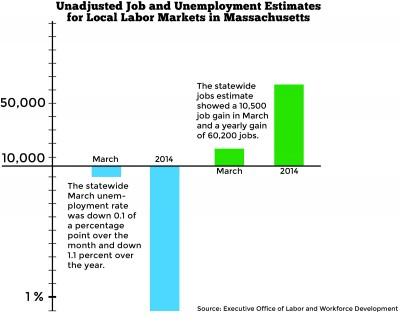The Massachusetts Executive Office of Labor and Workforce Development reported Tuesday that seasonally adjusted unemployment rates were down in March, with the largest job gains within the Boston-Cambridge-Newton area, according to a Tuesday press release.

The unemployment rates were also down in all 24 defined labor markets, including leisure and hospitality, education and health services, manufacturing, trade, transportation and utilities, government, professional and business services, mining and logging and construction. All of these outlined sections gained jobs, contributing to the lower levels of unemployment, said Ann Dufresne, communications director for the Executive Office of Labor and Workforce Development.
“In order to compare the statewide rate to the local unemployment rates, BLS [Bureau of Labor Statistics] estimates that the statewide unadjusted unemployment rate for March was 5.0 percent, down 0.4 of a percentage point from the revised February 2015 rate,” the release stated. “Over the year, the statewide unadjusted rate was down 1.3 percent from the March 2014 rate of 6.3 percent.”
The information is based on statistics gathered by the BLS, Dufresne said.
“We’ll conduct these surveys in households to do an analysis and a projection on the unemployment rate,” she said. “All we can tell you is that the numbers continue to head in the right direction. We continue to see growth in jobs. We continue to see growth in the labor participation rate, which is very important.”
The labor force participation rate is an important aspect of the seasonally adjusted unemployment rate, considering it may have contributed to the lower levels of unemployment, Dufresne said.
“We look to see how many people are of working age, are employed or unemployed and are a part of the labor force. We have seen, over the last 13 months, consistent growth, not every month, but we’ve seen consistent growth in the labor force participation rate, so we’re very encouraged by that,” she said. “That means that those people that might have been discouraged have been looking for a job and are now coming back into the labor force to look for work with the expectation that they might find work.”
She said that though the levels are positive, they do reflect some of the weather that impacted Boston over the winter.
“These are seasonally unadjusted numbers, so they’re going to reflect some of the large storms that we had in February and March,” Dufresne said. “But all in all, the monthly rates are down from before in all 24 areas, so it’s good news for Massachusetts and the local labor markets.”
Several residents said Boston’s economy is thriving because of innovation and new employment opportunities constantly popping up, but others said enough is not being done.
Daniel Mayo, 52, of Jamaica Plain, said new infrastructure is part of the reason unemployment is decreasing.
“They’re probably making more opportunities for everybody and building in certain places,” he said. “I see a lot of new things — a lot of new buildings and construction works.”
Robby Ramdin, 28, of Beacon Hill, said rising unemployment has been caused by strong contributors on the local and national level.
“We have a thriving economy,” he said. “Between the local economy being robust, we have biotech going nuts, we have finance amazing here, and also just the start-up scene in Boston is very strong. On a national level, we’ve had successful policies from Washington that are stimulating the economy and that combined with economy recovery is driving things. And also just the business cycle where cities, especially cities with a strong intellectual base, will thrive and be the forerunner of growth for the nation.”
James Lemans Miller, 41, of Roxbury, is unemployed and homeless. He said that the unemployment rate does not accurately represent what is really going on with employment opportunities.
“They [the government] should do more for the homeless,” he said. “People in the street care about the homeless more than the government does.”
Ethan Cappello contributed to the reporting of this article.


